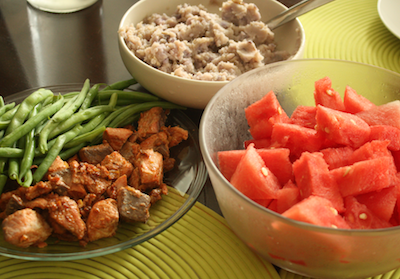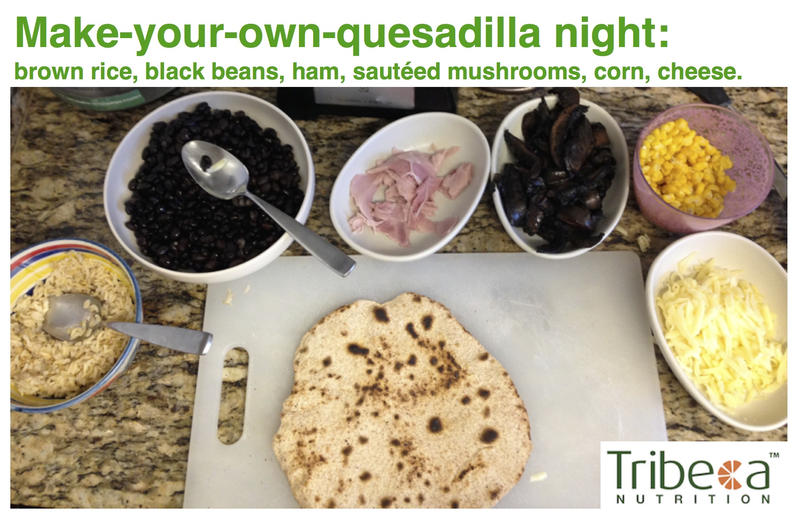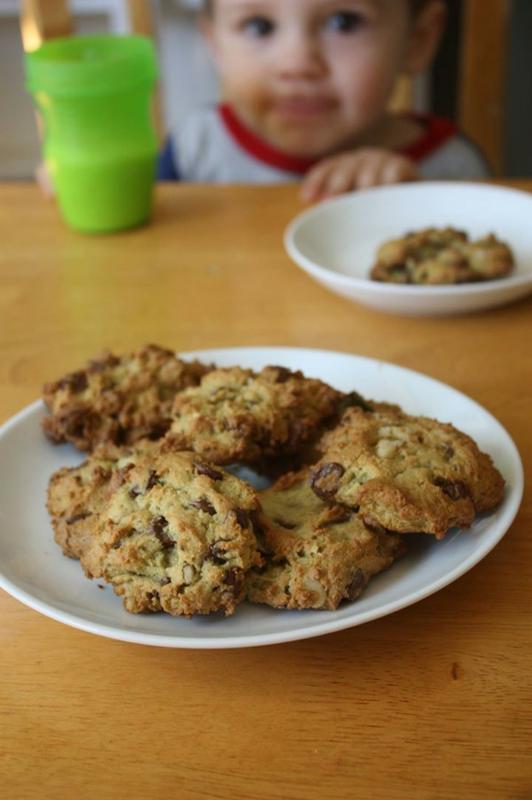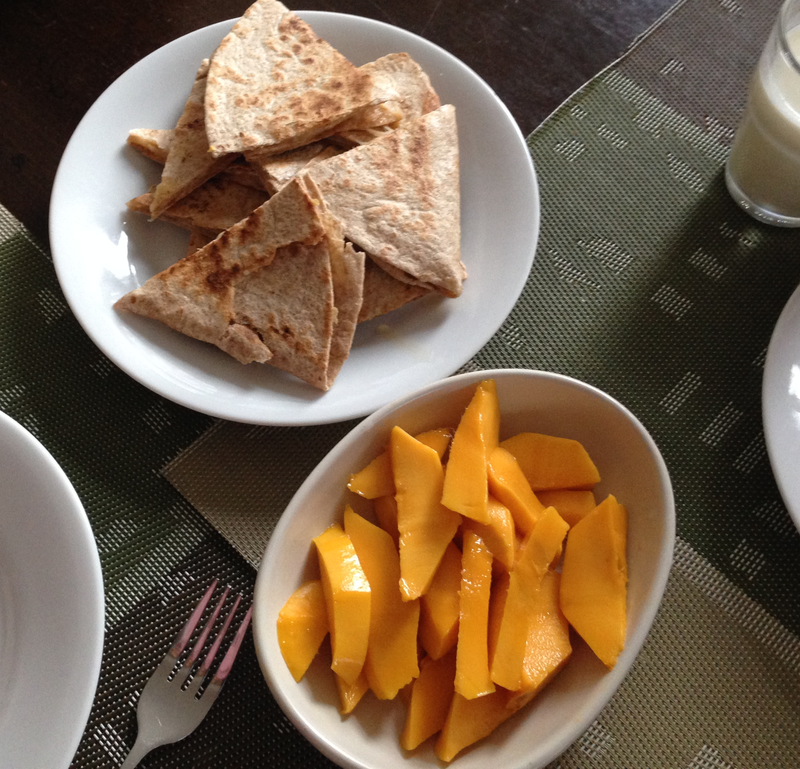What is a toddler-friendly meal?
When you think of a “toddler-friendly” meal, what comes to mind? Most people think of a “toddler-friendly” meal as a meal containing typical snack or “kid-food” like Macaroni & cheese, chicken nuggets and applesauce. Perhaps string cheese, cantaloupe chunks and cut-up toast? Maybe you think of foods that you’d be forced to exclude like salmon, brussels sprouts, spinach salad, spicy enchiladas or most things you and your partner enjoy.
We want you to know that any meal can become “toddler-friendly” with some minor adjustments. Whether you are a foodie who enjoys spending hours in the kitchen preparing gourmet vegan delicacies from local, organic ingredients or you are a stove-a-phobe who prefers preparing food from boxes—or somewhere in between—you don’t have to double your kitchen time to make simple family meals work. You can enjoy your favorite entrees and sides without alienating your toddler or having a food fight.
Here are some steps you can take to make meals in your house toddler-friendly.
Step 1. Serve a Safe Food
Think of a meal you love, that your toddler hasn’t yet touched. You can plan to include that meal soon and with confidence by providing a safety net that includes 1-2 foods that you know your toddler readily accepts. Such a safe food might include, but is not limited to: bread & butter, a large bowl of a preferred fruit, a stack of tortillas, a bowl of chips or crackers. For some kids it may be a favorite vegetable, chicken or meatballs. If the meal calls for it and your child enjoys it, plain rice or pasta works well for many children.

It might mean keeping some of the meat or chicken unsauced and also offering some sauce on the side. Few of these foods require much additional kitchen time, but give your child something simple and non-scary to eat when they are wary of the rest of the offerings. This isn’t food you give just to your child, but food that is served on the table for all—in enough quantity that everyone can get their fill—this isn’t always possible with meat/poultry as easily as it is with starches because starches are less expensive.
Step 2. Stay away from catering
Our main caveat is that you don’t make an alternate entree for any one person. In other words, don’t set out a PB+J sandwich for your picky one when you’re having lasagna. Don’t bake chicken nuggets when everyone else is having chicken fettuccine alfredo. That amounts to short-order cooking and will hold your child back in her learning. Why branch out if she doesn’t have to?
Additionally, don’t feel pressured to provide extensive variety with the safe food. If your daughter loves bread and will eat it readily when other things are less appetizing, keep putting bread out. An exception to the ‘alternate’ entree, would be when eating out at a restaurant—but that’s up to you.
Also one thing Adina has done is combine two different foods in a way that still allows sharing and doesn’t hint to the child that his eating is ‘different.’ She did this for lunch one day by making both PB+J and cheese-tomato sandwiches, but cutting them all into fourths and putting them all one one serving platter. Then each person could try one or the other or both—there was no distinction between the “kid sandwiches” and “adult sandwiches.”
Step 3. Deconstruct Meals
Thinking of serving tortilla soup tonight? Serve the soup, but also add tortilla chips, avocado, and other component parts on a platter separately. Your son will have the opportunity to taste the soup, if he is feeling curious, but can also eat individual parts without a lot of extra work on your part. You’ll all be sharing the same meal! See below an example of Make Your Own Quesadilla Night in Natalia’s house.

This can be done with many other foods too:
— Sandwich bar
— Baked potato bar
— Make your own pizza night
— Salad bar
— Taco night
Step 4. Don’t Make “Perfect” the Enemy of the Good Enough – (a.k.a. be willing to compromise)
In the world of nutrition and health there are a lot of gray areas. Each of us in this class (teachers or students) would probably disagree on some specifics about what people should or should not eat. We have vegans, semi-vegetarians, and omnivores amongst us. When a way of eating represents a deeply held moral or ethical belief, we would be hard-pressed to try to sway you. We want to respect your food values.
But sometimes ideals are just that…ideals. Sometimes food ideals can stand between you and a pleasant family meal and not just the pleasant family meal but the gradual progress in your child’s learning to accept new foods—including the foods of your ideals.
When you don’t meet your ideals it’s easy to feel guilty or throw in the towel and think it’s completely black and white: either Kraft’s Mac & Cheese that your kids will eat or 90 minutes in the kitchen with fussy results.
Very often when dietitians preach “family meals” what’s decoded by listeners (or readers) is an imperative to serve only foods according to a set of ideals (organic? low fat? Michael Pollan friendly? you name it). But what we really, truly mean is find a way to get food on the table that makes it worth the work and share that food—whatever it may be.
Remember the family meal is not just about food. And if one of your goals is to increase your child’s food repertoire it is counterproductive to create such tall barriers to getting food on the table that you can’t get food on the table. It is unfair to expect a child to not eat differently than you if he is fed differently than you. It sends mixed messages. Having influence is extremely difficult if parents don’t eat together with their kids.
Are there also foods that you avoid but are willing to feed to your child? Consider including these foods in the family menu—you can always add sides (if it is an entree) or use it as a side to your favorite entree. If you’re not allergic to it and doesn’t violate an ethical or moral dietary rule you follow, it’s worth including it, building on the influence of the other foods included on the table. It’s not catering if you aren’t cooking an alternate entree. Think of dinner rolls. They are really easy to like, but few kids will eat only that meal after meal after meal…ad infinitum.
So instead of letting the barriers to a perfect meal stop you from eating together, consider your food values and beliefs and see if there isn’t a place to make a compromise for the sake of growing together in your enjoyment of good food and good company.
Step 5. Serve dessert WITH the meal, not after

In most households, dessert is served at the end of the meal. When everyone has gotten their fill of the main course and sides and is patting his full tummy in satisfaction, the hostess clears the table, vanishes into the kitchen, and then reappears flashing a proud smile as she presents…DESSERT: The decadent reward for getting full on nutrition! The hard work is done, you may now enjoy a moment of pleasure.
Not teaching that lesson is one reason why we serve dessert with the meal in our houses. We don’t want to teach the unintended lesson that dessert is for full bellies. We want our children to stay tuned in to their signals of fullness and satisfaction. Sweets are desirable enough to children that they can learn to override their fullness if they have to do it to get cookies – especially if cookies are scarce.
A small study in Appetite demonstrated that kids will eat more calories in order to squeeze in dessert if it was served at the end of the meal. The study authors interpreted the results as a way to help kids eat fewer calories.
What we take from this is that the way we feed our kids can either support their natural self-regulation and ability to respect their fullness or it can teach them to overeat to get what they really want. That’s something else we don’t want to teach: that the meal should be considered ‘work’ while the dessert is elevated to a higher, more privileged status.
When it comes to picky eaters it is all too easy to slip into the dessert-for-broccoli power struggle: Okay, darling, eat another bite of your chicken and two more bites of your broccoli and then you can have dessert. We see this happen in the families who come to us for nutrition counseling.
We see it happen with picky eaters whose parents are worried because of their low weight and with picky eaters whose parents are concerned because of their higher weight. It’s not working for either group. Broccoli is wonderful! Chicken is wonderful! Dessert is wonderful! Yet we certainly make a big deal out of sweets. When dessert is a reward it takes on more power. Kids are already naturally drawn to strong sweet flavors, we don’t need to make those sweet flavors into a bigger deal. Plus bribery & coercion as well as other types of pressuring kids to eat typically makes them eat worse, not better.
What If That’s All They Eat?
You might now be wondering, what if that’s all they eat? How can it be okay for kids to survive off of cake and cookies until their tastes mature? Well, for one thing, dessert doesn’t have to be served at every meal or every day. How often you serve dessert is entirely up to you. And portion size matters because, it’s true, dessert may very well interfere with the nutrition of the meal if it is served ad libitum.
It’s Okay to Limit Dessert Served with a Meal
At meals we only serve one portion to each person at the table. And kids get a ‘child-size’ portion rather than a full adult portion (translate that to suit your preferences). It’s treated very much like a scarce food item (filet mignon, $9-a-pint raspberries, etc) and there are no seconds.Some examples of portions we’ve served: 1 square of chocolate, a lollipop, small slice of pie/cake, 1 coconut macaroon, small brownie, 2-3 tiny candy pieces, teacup full of pudding, teacup full of yogurt mixed with fruit, 1/2 to 1 cupcake (depending on size).If kids want to start with their cookie, fine. We know it’s not all they will eat. And even if your kids gobble up their small sweet treat and consequently decide they are done eating for the meal, they probably weren’t terribly hungry to begin with. If that is the case, without that dessert at the table, they would not have eaten much of anything anyway. The dessert didn’t ruin any appetites, it just masked their lack of appetite.With many kids, it seems the presence of dessert actually warms them up to the idea of coming to the table and relaxes them immediately, improving their attitude about the meal overall. This is not to say you should serve dessert to entice them, only that it won’t hurt matters when you do serve dessert. Occasionally, you may even find your child going back and forth between bites of dessert and bites of the main meal.
Step 6.Serve Unlimited Portions as Snack
Any food that is scarce, especially one as desirable as sweets, can create a strong preoccupation in a child. For some kids with a strong sweet tooth, that desire or preoccupation can lead them to overeat the desired food when they get the chance. Serving only a small child-size portion of dessert creates a kind of scarcity. To mitigate this scarcity and to allow children a chance to regulate their own portion size of a treat, we will, occasionally, serve an unlimited portion of sweets at snack time. If snack time is appropriately timed (so it’s not too close to the next meal) it won’t interfere with the next meal. Serve the sweet with a glass of milk (for example) and you’ve got a balanced snack!
Remember, once you have firm structure in place, eating happens seated at the table, not running around. Eating happens at set meal and snack times, there’s no all-day grazing. And you get to choose how often you serve various foods. But within that structure, the freedom of the Division of Responsibility, teaches some important lessons that would be tough to teach if we managed every bite.
Examples of Simple Family Meals:
pasta with a sauce (served separately if desired)+ steamed vegetables+fresh fruit
rice+black beans (can be from a can)+chopped up avocado
soup+dinner rolls+yogurt+fresh fruit
breaded chicken (aka chicken nuggets) + steamed broccoli+mashed potato
pizza+vegetable crudites+fresh fruit
canned tuna+pasta+chopped tomatoes
Between deconstructed meals, offering safe foods at “regular” meals, and aiming to simplify, you can make the sharing of a meal together easy on both you and your child.
To make meals more toddler-friendly, meet your child halfway – find a middle ground between the gourmet 3 course meals you might have enjoyed before kids and a “kid-friendly’ meal of chicken nuggets and fries.
More tips!
Busy schedules and dirty dishes challenge. To keep mealtimes easier, you can serve food in pots and pans or in glass storage containers that can be stored in the fridge with leftovers.
To keep the cost down. If your child is too young to serve food to himself, show him the food and offer to put some on his plate instead of pre-plating.
As you can see, a toddler-friendly meal does not require special kid-food. It just means that you plan meals with consideration of your child’s needs and current level of food acceptance. It might mean having an easy side dish, bread, or deconstructing the meal.
Coming Up Next: Video Case Studies — examples of feeding gone wrong.
Discussion: Please share 3 things you can change for making meals more toddler-friendly in YOUR household.
